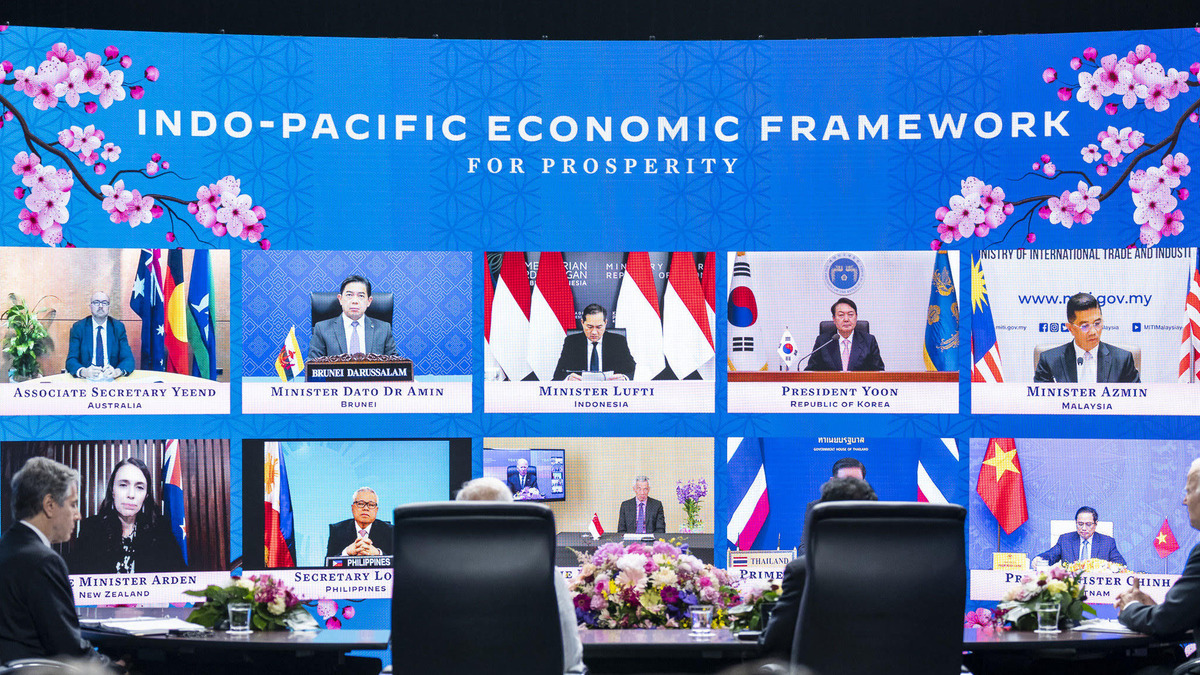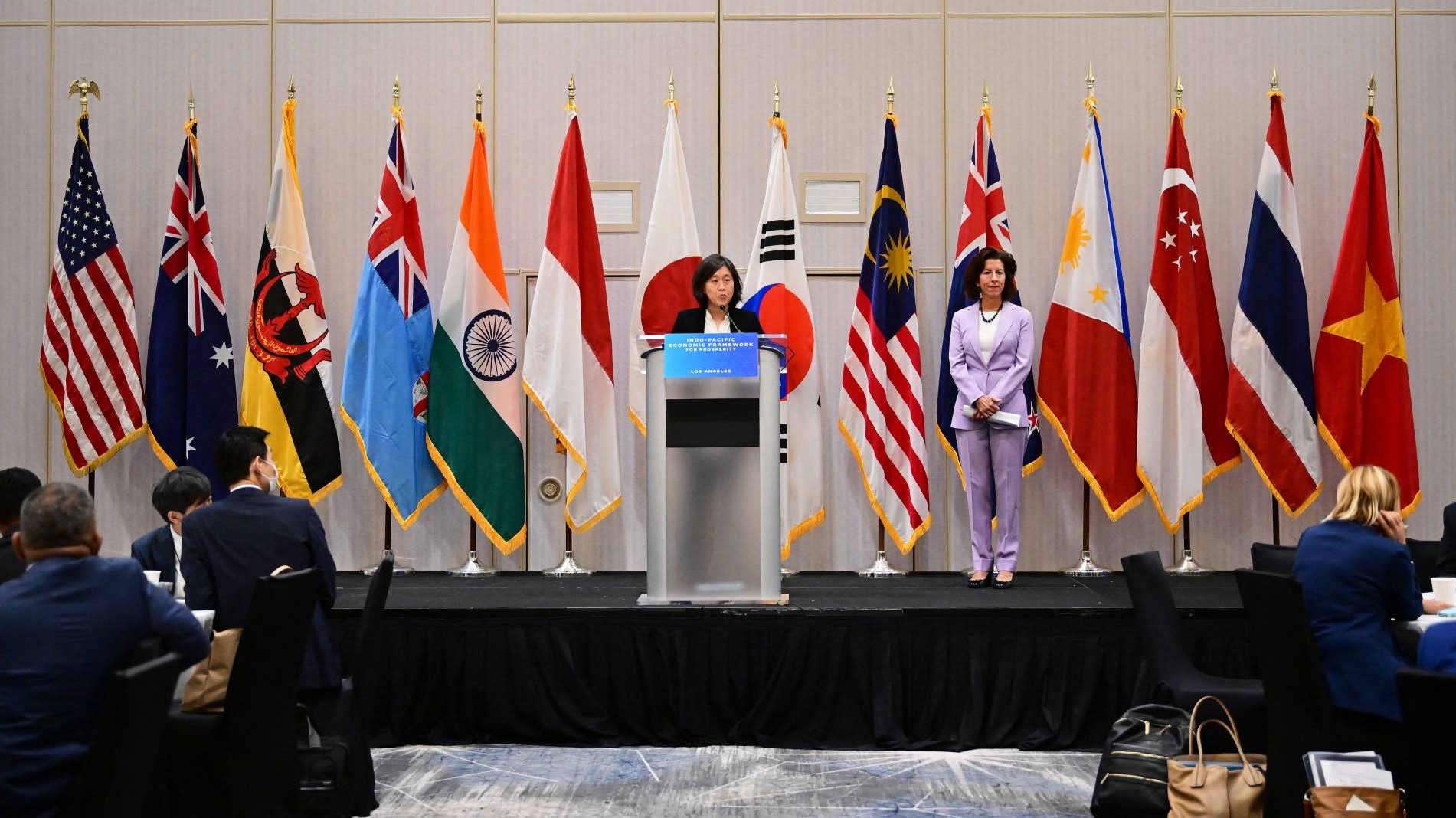Free trade agreements
Jump-starting US trade and economic engagement in the Indo-Pacific
Published 26 September 2023
Countries in the Indo-Pacific region are actively looking to both the United States and China as they seek to bolster their economic growth. Many countries in this region would prefer to align more closely with the United States, but they remain disappointed with Washington’s declining interest in trade agreements. The United States must intensify its economic and trade engagement with this dynamic region, going well beyond the current IPEF negotiations.
Countries in the Indo-Pacific region are actively looking to both the United States and China as they seek to bolster their economic growth, development, supply chain resiliency, and innovative capabilities. Many countries would prefer to align more closely with the United States, but they remain disappointed with Washington’s declining interest in trade agreements. Moreover, they are finding it increasingly difficult to resist China’s active overtures to strengthen economic ties.
The Biden administration is pursuing enhanced U.S. trade with the region through the Indo-Pacific Economic Framework (IPEF). However, the IPEF outcomes released to date in the supply chain pillar represent only a modest step forward, emphasizing process over substance. Further, ongoing IPEF negotiations on other pillars do not include the types of enforceable provisions contained in trade agreements such as the United States-Mexico-Canada Agreement (USMCA), which would allow the United States to secure additional market access for its farmers and workers or proactively shape supply chain decision-making. This omission raises questions about whether the eventual IPEF agreement will be seriously considered as an alternative to the more comprehensive trade agreements that China is offering.
To put it bluntly, if the United States does not take a bolder approach, we risk becoming spectators as our partners work among themselves and with China to strengthen supply chain connectivity and regional economic integration. This will substantially undermine the United States’ long-term economic, national security, and geopolitical influence.
China’s active trade agenda should be inciting a greater sense of urgency among U.S. policymakers to step up our regional economic engagement. Just as the Belt and Road Initiative allowed China to gain a strategic advantage over the United States with respect to its global development, infrastructure, and security objectives, China’s pursuit of regional trade agreements threatens to do the same with respect to supply chains and economic security. Further, the more countries in the region become economically dependent on China, the easier it will be for Beijing to use economic coercion against them to achieve a broad range of geopolitical objectives.
Paramount among China’s recent trade achievements is the 15-member Regional Comprehensive Economic Partnership (RCEP) — the largest trade agreement in the world — which entered into force in 2022. Under the RCEP, new tariff cuts among the members take effect each year, putting those countries on a continuous path toward greater integration with China. Even more economies are seeking to join the RCEP: Bangladesh and Hong Kong recently announced their interest. As more and more tariff reductions take place among the growing membership, the RCEP’s impact will continue to grow, to the further detriment of U.S. interests.
The RCEP is only the beginning of China’s ambition. In fact, Beijing is actively seeking membership in the Comprehensive and Progressive Trans-Pacific Partnership (CPTPP), an agreement that was largely shaped by the United States. Despite otherwise wishful thinking by U.S. policymakers, numerous CPTPP members appear positively inclined toward China’s membership. If China succeeds in its accession efforts, it will have scored a strategic coup beyond its wildest dreams. Not only will the United States have failed to achieve its original objective of using the agreement to set regional standards and norms without China, but China would be able to flip the table and use the CPTPP to set regional standards and norms without the United States.
Beyond the RCEP and CPTPP, China is engaged on other fronts. This engagement includes negotiations to join the Digital Economy Partnership Agreement, a leading regional digital pact among New Zealand, Singapore, Korea, and Chile. China is also working to upgrade its trade agreement with the 10 members of the Association of Southeast Asian Nations (ASEAN), focusing on emerging issues like digital trade and the green economy.
Successful negotiations on these and other agreements could turbocharge trade, investment, and supply chain connectivity between China and key trading partners. Indeed, trade between ASEAN and China is already increasing at an unprecedented rate — 64% from 2017 to 2022. Given the implementation of RCEP and negotiation of China-ASEAN FTA upgrades, the trend toward deeper economic ties between China and ASEAN is likely to continue to strengthen absent a change in U.S. policy. While the United States has not concluded a new comprehensive market access trade agreement in more than 10 years, China has supplanted the United States as the trading partner of choice for much of the world, and its dominance only continues to grow.
In light of the above, the United States must intensify its economic and trade engagement with this dynamic region, going well beyond the current IPEF negotiations. The United States can take several paths to achieve this goal, and none will be easy or without political and practical challenges. The following discussion sets out the key options in an effort to kick off a conversation about which path (or paths) is worth pursuing.
Options for Next Steps on U.S. Regional Economic Engagement
Rejoin A Reimagined CPTPP
The most straightforward way for the United States to step up its economic engagement in the Indo-Pacific region and provide a true alternative to China’s ambitious trade agenda would be to join the CPTPP. Of course, joining this agreement as it currently exists is not a realistic political option, nor would it achieve U.S. economic and strategic objectives.
In light of this, we recommend that the United States seek to update and renegotiate core areas of the agreement as we outlined in a previous report, Reimagining the TPP: Revisions that Could Facilitate U.S. Reentry. That report identified 12 specific areas in which the United States could work with its partners to modernize the CPTPP and address key shortcomings, drawing on lessons learned from the successful negotiation of the USMCA, among other more recent developments. The United States would need to negotiate changes in key areas, such as rules of origin, so that only parties to the agreement benefit, to ensure it does not become a back door for Chinese content; to strengthen provisions on labor and environment; to update provisions in areas like digital trade and intellectual property; and to add new sections on supply chains and economic coercion. One benefit of trying to achieve the United States’ goals on labor, environment, and digital trade through the CPTPP instead of the IPEF is that Indo-Pacific nations are much more likely to make meaningful commitments in the context of a deeper and more comprehensive agreement with market access commitments. Such commitments would also provide substantive incentives to link supply chains together, which are lacking in the current version of the IPEF.
Overall, we have received a very positive response to our work from a broad range of U.S. policymakers, stakeholders, and trading partners. There appears to be growing recognition that the United States is not doing enough to counter China’s ambitious regional agenda. Further, many of the countries in the region that are concerned about China’s growing influence have suggested a willingness to modify the agreement to meet the United States’ needs. On the other hand, many U.S. policymakers point to the political baggage associated with the CPTPP as an obstacle to moving forward with this approach.
Therefore, although we still view renegotiating the CPTPP as the preferred approach, we also believe the United States should consider other ways to achieve similar objectives. We outline three additional options here.
Embark On “Phase 2” IPEF Negotiations
The United States, along with 13 partners, is working hard to conclude the IPEF negotiations by November 2023 to coincide with the Asia-Pacific Economic Cooperation (APEC) Leaders’ Summit in San Francisco. The negotiations appear to be mostly on track, with the possible exception of more controversial aspects of the trade pillar, such as digital trade. Negotiating impactful agreements with such a diverse set of countries is no easy feat, and IPEF negotiators should be commended for the substantial conclusion of their supply chain work in May. That said, the supply chain results, while a useful first step, are modest in scope. If this is any guide to what the rest of IPEF will likely entail, we can expect limited outcomes in other areas as well.
This opens the door for the United States to inject an additional dose of ambition into the agreement and use it as the basis for further regional economic engagement by leading a “phase 2” IPEF negotiation following the APEC Leaders’ Summit. The supply chain work could transition from a sector-agnostic approach to sectoral negotiations focused on the most critical areas. For example, the United States could pursue negotiations with substantive commitments on areas like critical minerals, which are core components of many emerging technologies, or health-related products, which frayed during the COVID-19 pandemic. Other ideas for further work in this pillar are included in a recent ASPI issue paper, Strengthening Regional Supply Chain Resiliency through the Indo-Pacific Economic Framework (IPEF). Likewise, the trade pillar could be expanded to include provisions traditionally found in U.S. agreements, such as intellectual property, services, and industrial standards. One area ripe for emphasis is reducing non-tariff barriers and establishing common standards. These underappreciated measures can play a pivotal role in facilitating trade, investment, and supply chain integration.
Importantly, the United States could also propose tackling market access, which has been off the table to date, in a second phase. Such negotiations are crucial to prevent the United States from falling further behind in efforts to link supply chains across a range of areas in the region. For example, consider a business setting up shop in Vietnam that needs critical electronic components as inputs for final production. The decision to source these components from China at a 0% tariff instead of the United States at a 35% tariff would be a no-brainer given the current rates. That is exactly why market access negotiations are needed to change the dynamic. However, given the sensitivities, the United States could consider negotiating market access in an incremental way. For example, Washington could work with its partners to eliminate or reduce tariffs in targeted sectors, such as critical minerals, clean energy, or medical-related goods, which would help strengthen U.S. supply chains with like-minded countries.
Encourage New Partners to Dock Onto the USMCA
A third approach to enhance engagement in the region could center around expanding the most popular U.S. trade agreement in recent memory — the USMCA — which continues to receive broad bipartisan support in the United States. In light of the unprecedented backing for this trade agreement, this option may be politically and practically appealing. By “docking” onto the agreement, new partners — which could include the United Kingdom, Taiwan, or any number of countries in the Indo-Pacific (or Western Hemisphere) — would be expected to agree to the existing USMCA rules, including the strong rules of origin, robust provisions on labor and the environment, and equivalent market access commitments. This would help integrate the economies of this network with the United States as well as Canada and Mexico, both of which are CPTPP members.
However, this approach is not challenge-free. First, the United States would need to seek the agreement of Canada and Mexico, and it is not clear whether they would go along. Expanding the USMCA membership may be a particularly tough sell to Mexico, which could be wary of welcoming potential commercial competitors into the pact. Its advantage as the lower-cost supplier in the trilateral agreement and an attractive destination for foreign direct investment could be undermined by the addition of new members. Second, accessions would require congressional approval, which could create an opportunity for those who wish to make unrelated changes to the existing agreement. Third, the strict USMCA rules of origin, which were intended to promote manufacturing production in the three North American countries, could be diluted if new participants’ inputs could be cumulated in the origin calculations.
Start From Scratch: Embark on New Free Trade Negotiations With Indo-Pacific Countries
A fourth option to increase Indo-Pacific economic engagement would be to go back to the drawing board and develop a new template for a trade agreement. By doing so, negotiators would not be bound by the contours of any existing agreement but would have the flexibility to draw from all of them, including the USMCA, CPTPP, and IPEF, while adding new and emerging issues and tweaking existing provisions. As part of this effort, the United States could engage a wide range of stakeholders and enlist their participation from the outset, setting up an inclusive process and investing them in the exercise. Under a new negotiation, the United States would have the flexibility to enlist partners that share its values and norms and its interest in achieving ambitious and concrete results. Such an effort could start with a series of bilateral agreements or a small group of close U.S. partners, such as Japan, Taiwan, Australia, or Korea, and expand the list over time.
While starting anew has appeal, it also presents serious obstacles. Developing a domestic consensus on a new template for a trade agreement could take a long time — something that is in short supply given China’s ambitious agenda. Further, given the disparate views among stakeholders, it is far from certain that common ground could be found. Even assuming success on the domestic front, it may be difficult to attract new partners. The U.S.’ closest trading partners may be reluctant to embark on such an initiative, given their fears that a new administration may change course, as experienced with CPTPP; they may also have “new initiative fatigue,” as they are already parties to the CPTPP, RCEP, and IPEF. Finally, a bilateral approach would make it more challenging to fully integrate supply chains with the United States, and it would take much longer than China’s regional agenda.
Conclusion
There are a number of ways for the United States to get back in the game when it comes to trade in the Indo-Pacific. Reimagining TPP, punching up the IPEF, expanding the USMCA, or starting afresh are all options that deserve serious consideration to ensure that the United States can provide a meaningful economic proposition to the Indo-Pacific, as well as an alternative to China. Just as China has gained a major diplomatic and national security advantage over the United States through its Belt and Road Initiative, it is now potentially on track to do the same through its vigorous pursuit of trade agreements around the world, and specifically in its backyard. Regardless of the approach that the United States ultimately decides to pursue to address this concern, it must act with a sense of urgency.
***
This article was first published by the Asia Society Policy Institute in September 2023.
© The Hinrich Foundation. See our website Terms and conditions for our copyright and reprint policy. All statements of fact and the views, conclusions and recommendations expressed in this publication are the sole responsibility of the author(s).







